While we were hauled out in Samal, Dave had taken the saildrive legs out for some maintenance.
Once we got underway, Dave noticed that the port saildrive gear oil was looking kind of "milky". This is an indication that salt water has gotten into the gear oil. Not good. Since he had just re-done the seals in the lower unit, he was scratching his head about the cause. He thought maybe he had pinched an o-ring when he was putting it back together. The starboard saildrive looked better, but still showed a little milkiness. He did the best he could on the port drive to suck out all the bad oil and replace with good oil. A few days later it was looking very milky again.
So we continued on, using only the starboard engine. This is OK, we can make 5 knots under motor with no adverse winds, and maneuvering is a little tricky, but we managed. It required a haulout to look at the problem and try to fix it, and we knew that there weren't any convenient haulout facilities available in eastern Indonesia. So we started looking for a place to haul out on the beach. At first we thought about that perfect beach in Batanta (near Sorong) where we'd changed the zincs in July or August 2016 (see pictures by finding our blog entry about that "haulout").
But the tide cycle wasn't right--the big low tide was in the middle of the night, and all our buddy boats were just about to head east from Sorong. So we started looking for likely spots further east, for a few weeks hence where we might have a good daytime low tide. We found a lagoon 20 miles east of Biak that looked possible. There were a lot of beaches, it was protected from SW-N-SE, and the time we would be there coincided with the next bout of high tides. But... again the lowest tide, where we'd have plenty of time to work on the saildrives, was in the middle of the night. But as we proceeded further east beyond that, the tidal rhythms changed, and the tides are not as big. So it had to be Jan 23 or 24, or forget it til we found a proper haulout facility somewhere in Papua New Guinea or the Solomon Islands.
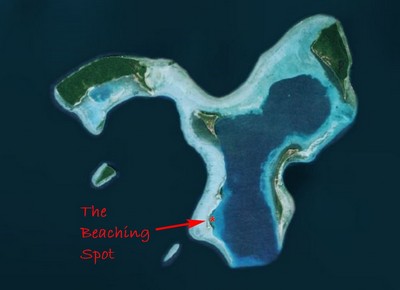
So that's why our time in Biak was so rushed--we needed to get out to the selected spot on the 22nd and scope things out--look for a place we could get into at high tide that would be a level spot at low tide. Once we got to Mios Weundi (Paidado Islands) late in the afternoon of Tuesday the 22nd, we were surprised to find that our haulout beach was occupied with some fishing families, complete with kids, dogs, chickens, etc. Hmmm...
The next morning we went in in the dinghy at high tide to check depths and just look at the spot. It turned out that our perfect beach (selected via GoogleEarth) was inaccessible because there was a ridge of sand blocking our access, even at high tide. Dinghying around in the curve of the island, we found another spot that looked good. The only drawback was that it was covered in a fine grass. Not as nice a work platform as nice sand, but in actuality, the grass was better because it held the sand together, and made a nice firm surface.
We met who appeared to be the headman. He spoke no English and we no Indonesian. But with signs Dave attempted to tell him that we planned to beach the boat there at 6pm. I am not sure he understood, but we got "bagus" (good) and an OK sign. We didn't--but should have--brought a gift in for him--a few cigarettes, a small bag of rice, something. At around 5pm, our buddy boats arrived from Biak (thank god, as we couldn't have managed without their help). Jon on Ocelot and Chris and Sue from Indigo II volunteered to (a) help us get the boat beached at sunset and (b) come in at midnight and help with the work on the saildrives. Both boats are catamarans and were keen to see how we did the project.
It was no big deal getting beached. Though high tide was not til around 8pm, we went in just before dark, and made sure we got secured in place when the tide was a little lower than the high the next morning. If we couldn't get ourselves off in the morning, we'd be stuck for about 2 weeks til the tides got higher again! We drove in slowly to the selected part of the beach, and when we stopped, I jumped off the back with the Fortress anchor, and walked it out 100 feet to secure our stern. Dave dropped the 100 lb Spade off the bow and Jon and Chris muscled it out ahead of us about 100 ft. Then we tightened it up and had happy hour.
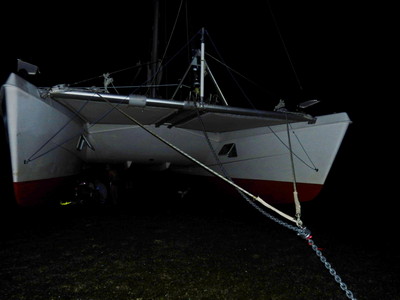
As soon as we got set, the wind uncharacteristically switched to the north (from WNW). A squall was passing south of us, and we were not very protected from the north. I worried for an hour or two but it all amounted to nothing. As the tide rose to its peak, a slight swell started moving us around, jerking us back and forth like a yo-yo between anchors. It seemed we'd never settle back down in the sand. But of course we did. (Dave took a nap, but I couldn't as I was fretting about the weather, the jerking, etc).
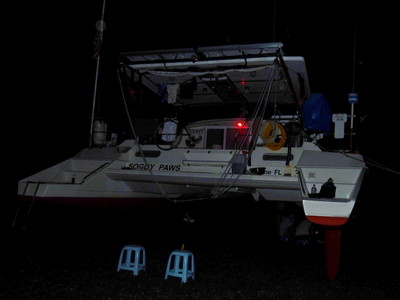
Finally about 10pm we were firmly on the bottom, and by midnight, we could see wet seagrass under the boat. Before all the water went away, Dave went in our dinghy and collected our volunteer helpers, and they couldn't get the dinghy all the way back to the boat, so he tied the painter off to the stern anchor line. And they set to work.
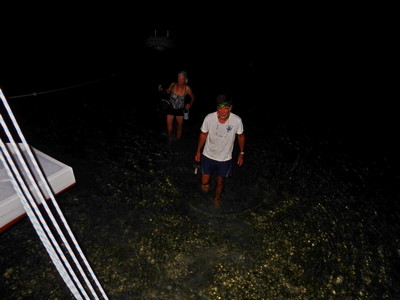
I was designated to stay on board to hand things down, and take things up so they could be worked on. Dave, Jon, Chris, and Liz were working on first the port saildrive and then the starboard. They drained the gear oil out and then took the lower units off.
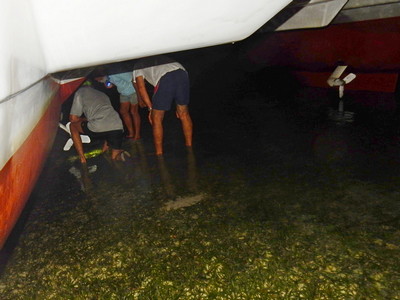
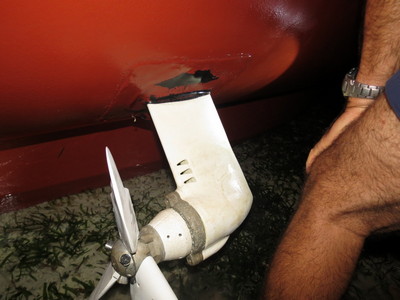
Note Rubber Boot at Top of the Drive--glue isn't holding well. That rubber boot needs to be removed and re-glued after re-assembly.
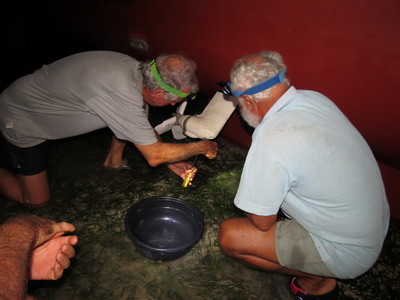
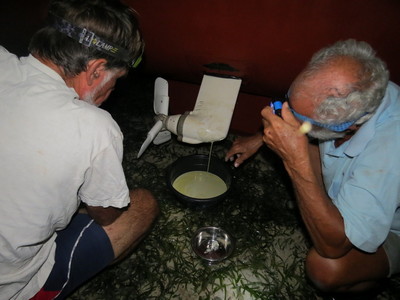
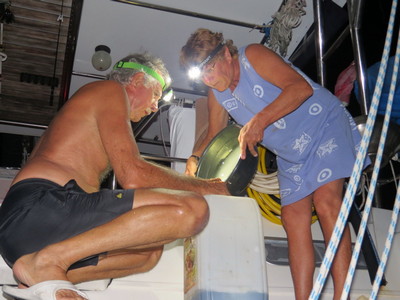
After the oil was drained, they flushed each saildrive with a little bit of diesel, to make sure there was no salt water left in the drive.
Then they took the first drive apart, and Dave carefully inspected the situation, to try to determine why it was leaking.
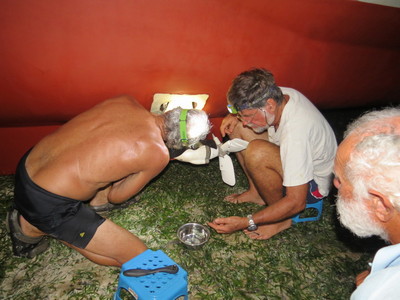
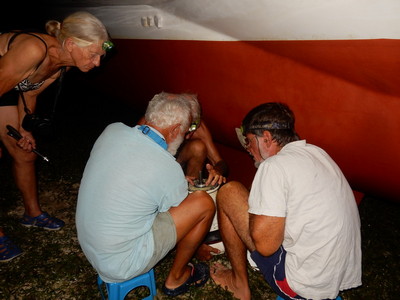
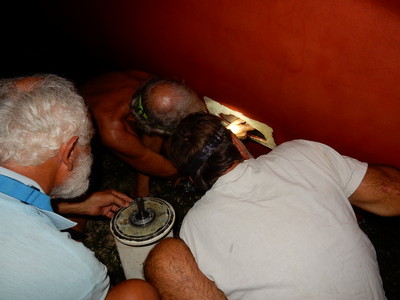
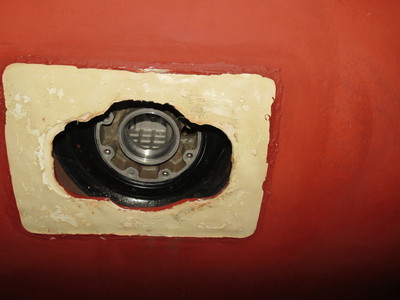
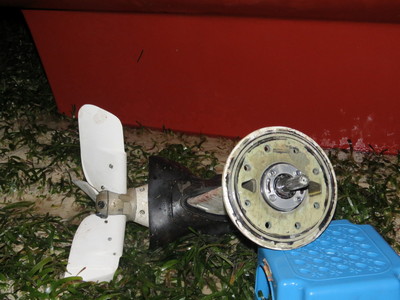
The seals and o-rings looked OK, but Jon said the bolts on the port drive were very loose. He suspected that was the cause of our leak.
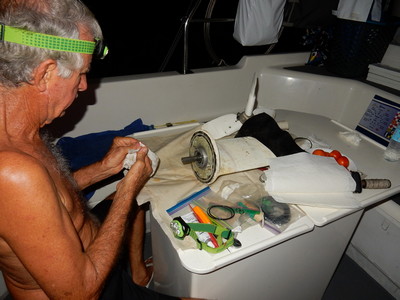
Dave brought each lower unit up into the cockpit so he could look at the seals and o-rings and make sure the mating surface was clean. I spent some time cleaning all the bolts in diesel. Meanwhile the tide went out and out. Eventually we had a grassy spot behind out boat going out nearly 200 feet.
Dave couldn't find anything wrong looking with either the port or starboard lower units, so we had to conclude (hope) that the problem was that the bolts either didn't get tightened properly, or hadn't stayed tight. This time, instead of using a grease on the bolts, Dave used a threadlock, and with everyone looking on, torqued each of the bolts.
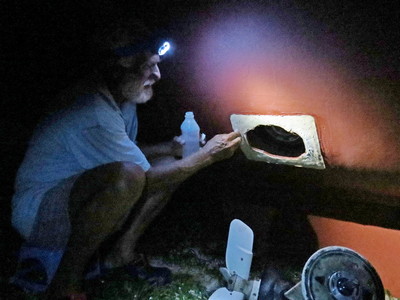
The final step was putting the rubber "boots" back around the saildrives. These are flat oval-shaped pieces of rubber that are slit on one side to fit around the saildrive. They are supposed to be glued onto the hull over the opening that the saildrive protrudes through. This is the 3rd iteration for us trying to get these boots on. The first time, we had someone else do it, and they stuck pretty well. Last year, we used truck mud flaps for the boot material, and Sikaflex for the "glue". They didn't hold very well. This time, Dave had bought proper Yanmar boots, and they were a soft flexible rubber. Again he used Sikaflex. And they were already starting to come off. So Chris on Indigo offered that he had had success using Super Glue, and offered a handful of small tubes of Super Glue. They prepped the surfaces of the rubber and the hull as best they could under the conditions, but really struggled getting the boot to stick. The soft rubber wasn't very conducive to getting stuck well, and the boots were a little warped already. They ran out of Super Glue trying to get the first one done, so we used Sikaflex again for the other drive, as the tide was starting to come back in.
Meanwhile as we'd been working, a big black storm built to the SE of us, and started to move in and blot out the moon. We could hear the wind howling in the trees ashore, and I was again worrying about being exposed and the weather. But when I switched on our wind instrument, we had only about 5 knots. Fortunately, we were well protected from this storm.
While Jon and Chris and Liz were working on the boots, Dave and I were filling the saildrives with gear oil. By 0430, everything was done, and there was nothing left to do but wait for the tide (and hope the wind died out). The last thing our weary helpers did was drag the heavy bow anchor back close enough where we could lift it easily when the tide came in.
When it was time to take our friends back to their boats, the tide was still out enough that he dinghy was still high and dry. But the slippery grass made it easy to drag the dinghy out to the water, still about 50 ft away. By the time he came back to Soggy Paws, the water was up enough that he could drag the dinghy close enough to secure it to the boat.
AT 0730, we felt the first bump, meaning the tide was starting to lift us off the sand/grass. About 0810 we were floating enough to kedge ourselves outward using the stern anchor, and by 0820 we were anchored back next to the other 2 boats. The Fortress was so dug in that we put a buoy on it and left it to retrieve with the dinghy. It took Dave a good 10 minutes of standing there and wiggling and digging around the flukes to get that anchor free.
We all planned to stay there for the day and rest up, get ready for passage-making, and wait for Berzerker to arrive from Biak. But about 1030, a boatload of locals, including the head man we had "talked" to, came by our boats asking for money. We felt that we had used their beach, and didn't mind giving them 100,000 Rp ($7 USD). The other two boats were reluctant, because once the locals receive money from one boat, they are going to expect it from everyone else who stops there. Reluctantly one boat gave them 20,000 Rp, and the 3rd boat refused, saying it's not customary to charge anchoring fees in Indonesia. The local men were happy with our 100K, but not happy with the other two boats, and the vibe wasn't good. So we collectively decided to pick up anchor and move to another anchorage, another atoll, 13 miles to the west.
Though we were all tired, we had a fairly pleasant sail and managed to find a good anchorage in NW conditions at Manggawandi. We were pleased to find that both saildrives seemed to be working OK, and no milky stuff in the gear oil. We had used both engines at idle speed to motor off the beach and out to the anchorage, and started out with just the port engine.
Once we started the starboard engine to motor in to our new anchorage, it shutdown on an overtemp after running at speed for about 10 minutes. Obviously we had a cooling water issue in that drive, from running the drives while we were hauled out (to circulate clean diesel in the lower unit, prior to refilling with gear oil, to flush the salt water out). We switched to the port engine and carried on in to the anchorage. Dave eventually spent half a day getting the starboard saildrive cooling water circulating again.
Manggawandi is a very large bay with a nice sand area in about 30 ft. One friendly person stopped by in a canoe and told us we were welcome, and did not ask for money. We could see and hear the surf breaking out on the reef, but the anchoring area was pretty good. 01-17.636S / 136-36.364 E
Berserker finally sailed in at sunset. We had a short happy hour on Indigo, and planned leaving for the Ninigos in the morning.
-----
At 1/28/2019 2:15 AM (utc) our position was 01°13.32'S 144°17.96'E
Many years ago in the Ft. Lauderdale Marina Motor Inn I saw a 40 ft. cat with sail drives at the vertical stern of each hull. The holes were above the waterline and the drives swiveled sideways to come completely out of the water.
ReplyDeleteAll the places you are visiting; for better or worst, you are seeing the world in a way I continue to imagine...
ReplyDelete